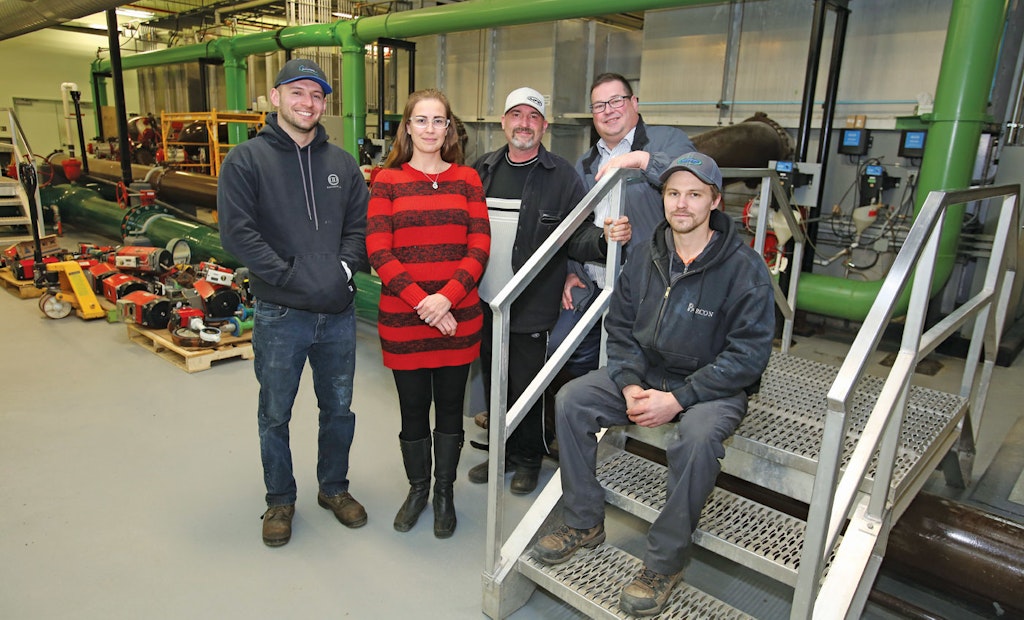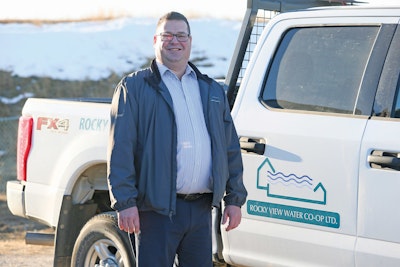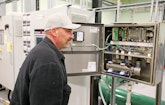
The Rocky View Water Co-op staff includes (from left) lead operator George Grosariu, Office Manager Brandy Jarvis, Operations Manager Lawrence Michetti, General Manager Brad Mason and operator Corey Bureau.
The Rocky View Water Co-op was losing a massive volume of water. Accurate metering was as problematic as leaking pipes.
The co-op was founded to serve a dozen residents and agricultural customers in a rural area just northwest of Calgary, Alberta. But it suffered growing pains. An initial water audit in 2014 estimated system water loss at more than 41 percent. To restore distribution system integrity, the co-op has discovered that accurately measuring nonrevenue water is half the battle.
The co-op was formed under the Alberta Rural Utilities Act in 1992. As the province’s largest water co-op, it serves 2,300 members. A not for profit, the utility operates under the direction of an elected board. Members of the co-op must make a one-time purchase of a Class A share, entitling them to vote, and at least 10,000 Class B shares representing one capacity unit — 6 gallons per minute at a minimum pressure of 40 psi. Water used is billed at a metered rate.
Better accounting
The co-op first began to address water loss in 2013, dividing total water consumption figures by distribution totals and ballparked water losses at 39 percent. The first water audit in 2014 looked worse, with nonrevenue water calculated at 41.5 percent. In early 2015, the co-op installed flowmeters to create five district-metered areas, or DMAs, but the data was still not conclusive. The utility had also begun a proactive program to replace all of the water meters on a five-year schedule to more accurately assess consumption.
“Everyone was doing the best job they could,” says Brad Mason, general manager, who joined the utility in mid-2015. “However, the board was in transition from a working board to a policy-driven board. When I arrived, part of my goal was to bring focus and direction to the co-op, and one of those focuses was reducing water loss.”
In the fall of 2015, Mason proposed that the board adopt the American Water Works Association’s free M36 Water Audits and Loss Control Programs, including its Water Audit Software package.
“We sold it to the board as a recognized approach to water audits, applying accounting principles to water consumption,” Mason says. “As a policy-driven decision, it allowed us to say what we were going to do and how we were going to do it and where we could get the best bang for our buck, instead of throwing darts at the dart board.”
The co-op’s first M36 water audit was completed in late 2015. “It was disheartening because we calculated our water losses at 60 percent,” Mason says. “We realized that it wasn’t necessarily real water loss, but the result of our data getting better and leaks that were worse than we had thought.”
Rocky View Water Co-op wasn’t simply counting on the audit to solve its water loss problems. It concurrently launched an accelerated multipronged effort involving effective asset management, more effective system metering and monitoring, and rapid repair and replacement of defective infrastructure.
Assessing assets
While the co-op’s nondistribution assets were already part of the accounting system, distribution assets were not. The utility purchased NEXGEN Asset Management Software to record all distribution assets and estimate their value. That task is about two-thirds complete. All system assets are currently mapped and accounted for and are being assigned GPS coordinates using a Leica Geosystems GR Zeno 20 data management system with HxIP.
“Our next step will be Esri mapping to be able to identify those lengths of pipe that experience the greatest number of leaks,” Mason says.
The distribution system is relatively young at 15 to 25 years old. One third of the system is bell-and-spigot PVC pipe. The newest pipe is fused HDPE. Pipe ranges from 2 to 8 inches in diameter, although most measure from 4 to 6. Pipe is buried about 8 feet deep.
“I would rate the overall pipe condition a C,” Mason says. “The bell-and-spigot pipe has a high leakage rate, and the oldest pipe was installed with no bedding or improper bedding and this results in the most breaks. This is Chinook country, so we have multiple freeze-thaw cycles in a winter, with temperatures rapidly shifting as much as 50 degrees F.”
Completion of the asset management plan gave the utility a solid basis to pass its 2018 capital asset plan for the distribution system.
Quicker response
As a small utility, Rocky View Water Co-op contracts all of its construction and repair work to outside providers.
“However, as an organization, we were not responding to potential leaks as fast as we could,” Mason says. “As an example, we had two leaks in 2017 representing water loss of more than 8 gallons per second. One was located inside a week and the other in a day. In the past, they might have taken three weeks or longer to locate.”
The co-op also now stresses higher quality repairs. For example, a large number of customer connections were originally completed with plastic sliding wedge fittings.
“They seem to have a 20- to 25-year life span, and we have literally hundreds out there,” Mason says. “It’s our most common cause of leaks. My grandfather was a saddle maker, and he had a sign up in his shop in 1902 that said, ‘If you want it bad, you’ll get it bad, and if you want it cheap, you’ll get it cheap.’ Instead of replacing those fittings with more plastic, all new installations and replacements are brass. If we do a service dig, we want it to last for 25 years.”
Meters matter
Mason accelerated the existing water meter replacement program to conclude in 2017.
“It gave us a huge bang for our buck,” he says. “The worst of the older meters were underreporting water use by 20 to 30 percent. The worst case was 78 percent and one customer had no meter at all for seven years.”
The meters were replaced by the E-Coder)R900i manufactured by Neptune Technology Group. “We now have only 20 meters left that aren’t on the AMR platform,” Mason says. “Last year, we purchased the data logging component to that system. We can now read all of the meters in an afternoon using a laptop and remote reader. Although we bill quarterly, we started to read monthly because the meters have the capacity to identify a possible intermittent or continuous flow leak, so we can send a report to the customer.”
The utility also tested its production meters and is replacing one of them this year after discovering a potential variance of 30 to 40 percent. “If the production figure is wrong, then everything is wrong,” Mason says.
The original five DMAs have also been reduced to three, following discovery during a leak repair that two of the DMAs were cross connected. The two DMAs will only be restored following further validation.
“What that process also showed us is that we should have started by monitoring pressure instead of flow,” Mason says. “Flow only measures volume, which can be valuable for longer term trends, but you can get a reading on pressure anomalies instantaneously, even if your DMAs are poorly designed.”
The utility now performs daily reads on DMAs and has begun to install remote pressure monitoring stations with alarm set points. The co-op has budgeted for installation of 15 to 20 stations over the next several years.
Clamping down on leaks
Crews use a Hermann Sewerin GmbH AquaTest T10 acoustic leak detector to pinpoint suspected leaks.
“With plastic pipe, it’s hard to do traditional acoustic leak detection, so we’ve been using it on curb stops,” Mason says. “It’s not as accurate as it is with metal pipe, but we have successfully detected a number of leaks. Our normal flow is 5 to 6 decibels, so everything above that is probably a leak. We’ve also been experimenting with driving steel stakes into the ground near plastic mains to see if it improves our acoustic readings. It’s worked at least once, so we’re continuing to experiment with that idea.”
Leak repair efforts have also identified a lack of main valves required to isolate pipe segments. A recent main repair required contractors to suspend service to 130 customers. Rocky View Water Co-op has budgeted for 25 hot tap insertions in the longest lengths of main over the next four years.
All of the efforts have paid off. The 2016 water audit reported nonrevenue water at a little over 23 percent. “By our early estimates, 2017 should show nonrevenue water between 18 and 19 percent,” Mason says. “Some of it is due to improved metering, but part of it is definitely improved leak monitoring, detection and system repair. I think of the co-op as just coming out of its rough-and-tumble teenage years. We’re now heading into maturity.”
Five tips for using the American Water Works Association M36 Water Audit tool
1. There’s great value for small utilities in conducting the water audit.
“Even if your resources are limited, at least you know the issues and what you can afford to focus on.”
2. Read the manual.
“It’s very easy to populate the data, but in hindsight, we realized we should have read the manual more carefully to make sure we had the most valid data for each entry. M36 offers a great resource manual and a great guide.”
3. Don’t place too much faith in your first audits.
“Even if early results are inaccurate, they’ll point you in the right direction and help you decide on an action plan to get to the next level of accuracy. Producing valid data can be time consuming, and the process may take as long as five or six years.”
4. Consider both pressure and flow in your models.
“In our experience, we should have looked at pressure zones first, because they provide instantaneous data, and flow zones second.”
5. Use the tool to create a water loss control program specific to your utility.
“This policy document is a touchstone that should be used throughout the process, to remind you of the why, not the what.”









